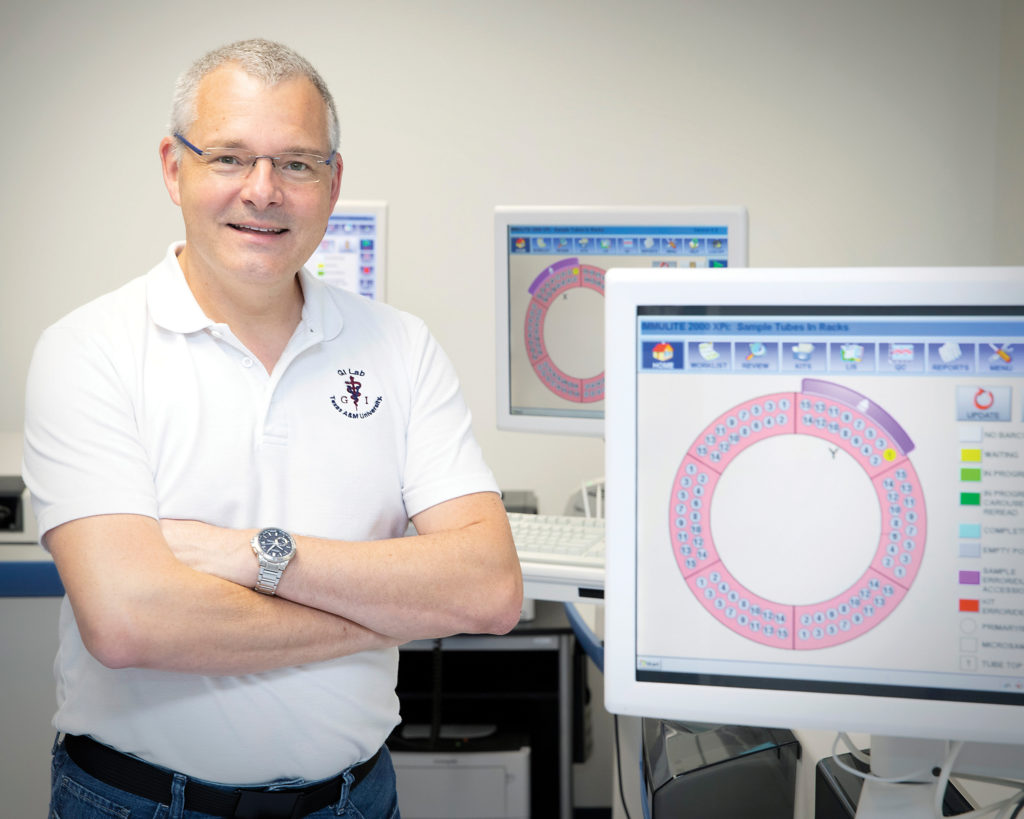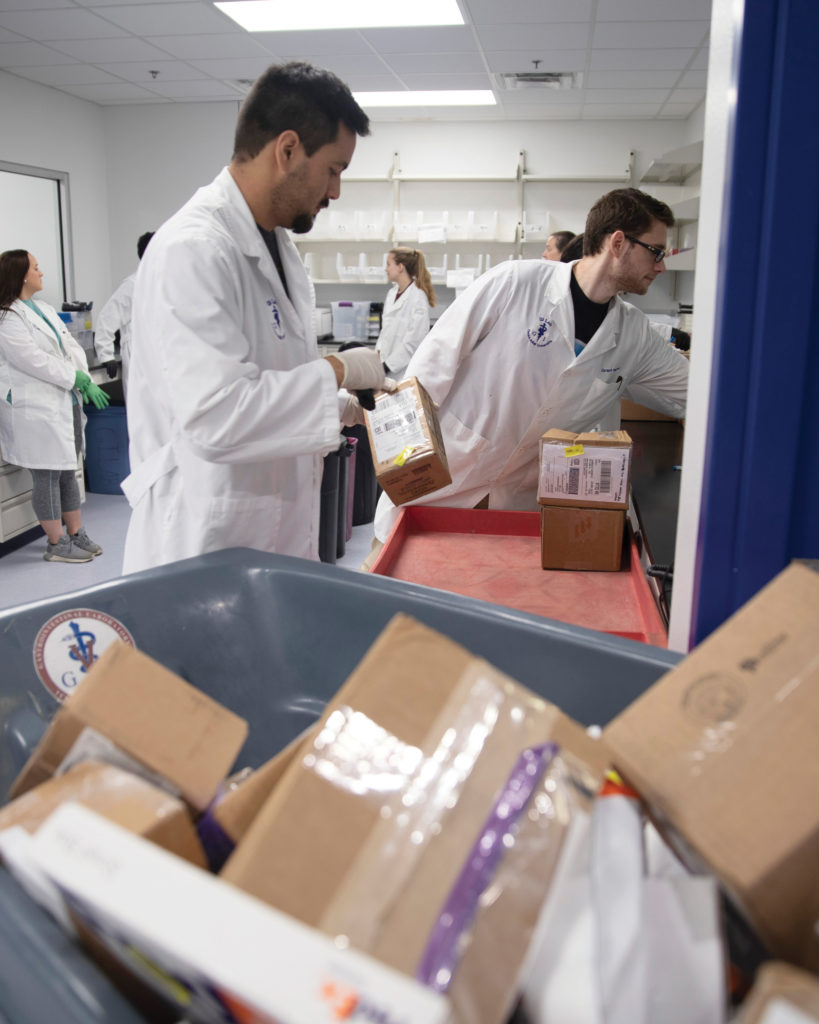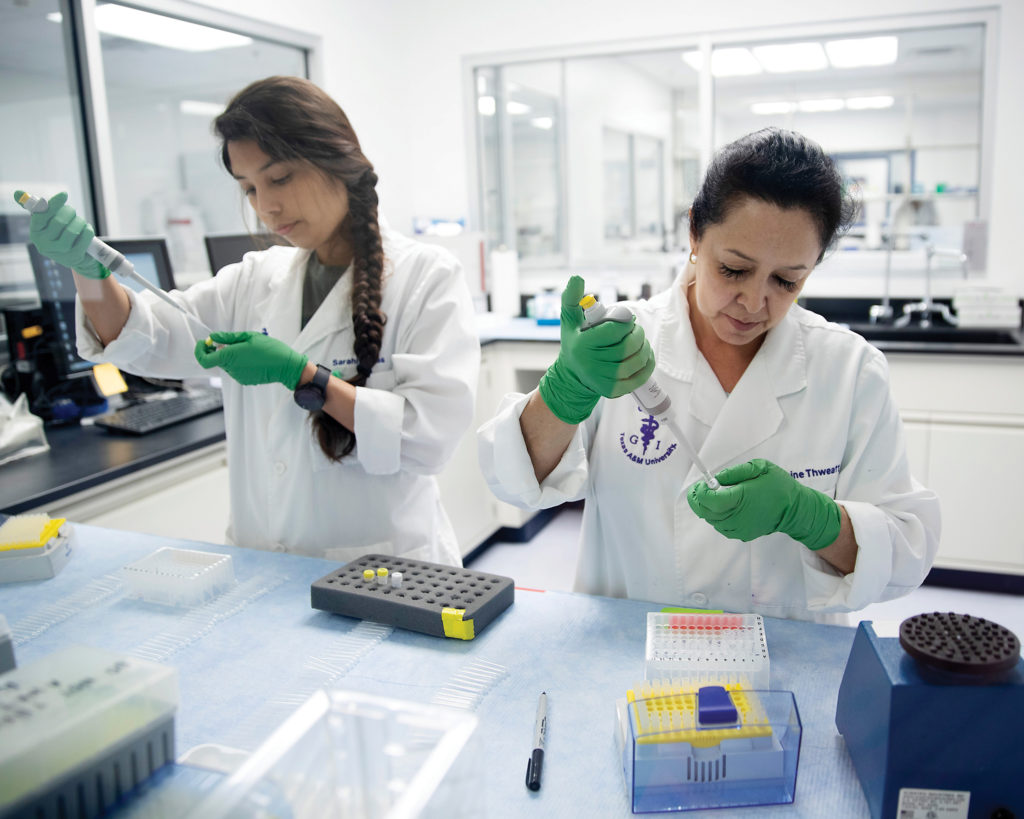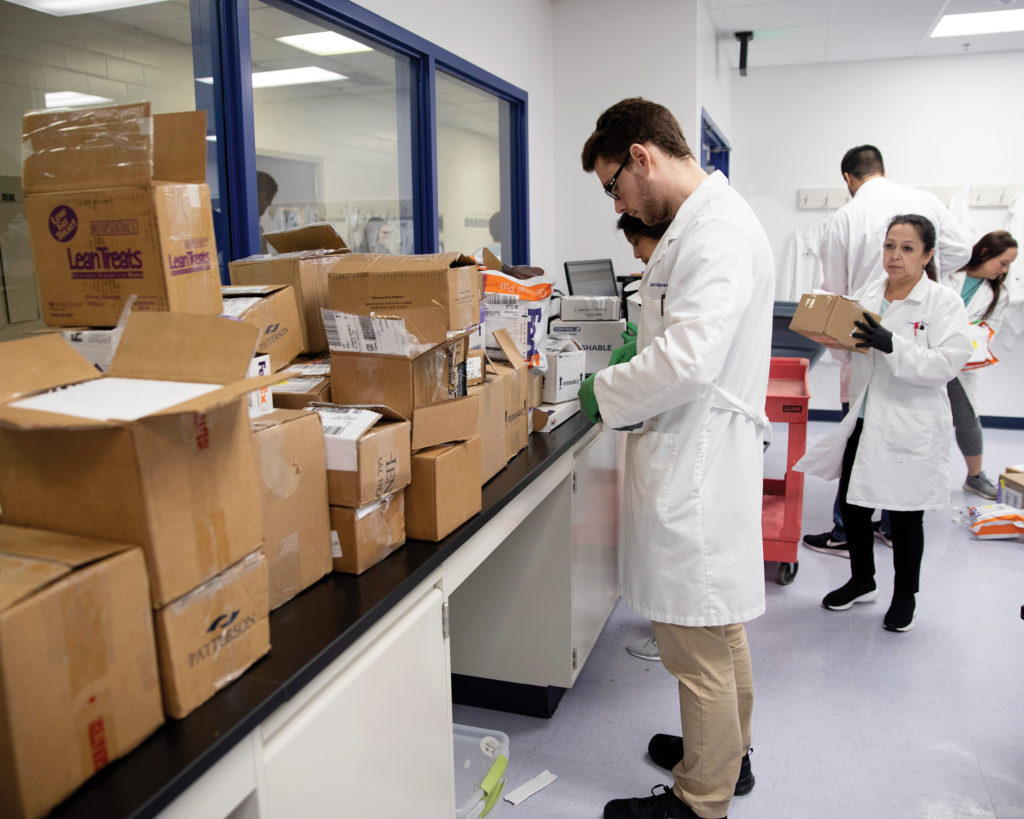Testing for Trouble
Story by Dr. Ann Kellett
As the college’s newest Distinguished Professor, Dr. Jörg Steiner has led the Texas A&M Gastrointestinal Laboratory (GI Lab) in making major advancements in veterinary medicine through the development of diagnostic tests.

Pancreatitis—when the pancreas becomes inflamed or undergoes structural damage—is extremely common in both dogs and cats. An estimated 1 out of every 100 dogs and cats are afflicted every year.
While a few factors are thought to be associated with pancreatitis, including diet (in the case of dogs but not cats), adverse drug reactions, and even scorpion stings, no one knows exactly what causes it. Most dogs and cats that experience pancreatitis are adults and miniature schnauzers are predisposed, but pancreatitis can happen in any dog and any cat.
Diagnosing pancreatitis is difficult, in part because its symptoms, especially in patients with mild disease—poor appetite, weakness, and diarrhea—are vague and found in many other illnesses.
Even worse, there is currently no treatment.
“That’s true for humans, as well as dogs and cats—there’s no treatment,” said Dr. Jörg Steiner, a professor of small animal clinical sciences, and director of the GI Laboratory at the Texas A&M College of Veterinary Medicine & Biomedical Sciences (CVM).
“If you are a human with pancreatitis, the medical profession does almost anything to try to save you,” he said. “Since there’s nothing you can do for dogs and cats except try to keep them alive, pet owners often think the diagnosis is not that important.”
For The First Time—A Quick, Accurate Diagnosis
But that is changing. Now, veterinarians have a quick and accurate test for diagnosing or ruling out pancreatitis.
The pancreas aids digestion by producing several important enzymes, including pancreatic lipase, an enzyme that breaks down dietary fat. In cases of pancreatitis, pancreatic lipase is released into the bloodstream.
“Our diagnostic test for pancreatitis was an accident, like most good inventions,” Steiner said. “The goal was to develop a new diagnostic test for gastritis in dogs. The idea I had, working with my mentor, Dr. David Williams, was that there would be a lipase made in the stomach and if it could be measured in the blood, it would be possible to diagnose gastritis.”

Pancreatic lipase is just one of more than a hundred different lipases swirling around in the body, and until Steiner’s breakthrough research, it was not possible to measure what was produced from a single organ.
Steiner and Williams began developing a test to identify pancreatic lipase in the blood in 1996 as part of Steiner’s doctoral work at the CVM. They finished in 2000 and the test was licensed in 2003. When it was put on the market two years later, it became the most accurate method of detecting pancreatitis in dogs.
“We offered it to veterinarians and probably ran about 50 tests a week,” Steiner said.
In 2005, Steiner and Williams, now at the University of Illinois, collaborated with veterinary giant IDEXX, which has more than 8,000 employees in 175 countries, to improve the test and make it more commercially viable.
“IDEXX did some studies and bought the license from Texas A&M and developed their own, more advanced version of it,” Steiner said.
The result is the accurate and easy-to-read Spec cPL® Test, that lets veterinarians know if a dog with symptoms of pancreatitis actually has the disease within 24 hours.
“Partnering with industry has produced many mutually beneficial relationships,” Steiner said. “They have some proprietary knowledge about how to make an assay more stable, how to make it more reproducible, for example. Putting our resources together is what led to a much more robust test.”
One-Day Turnaround, World-Wide
Now, the test is available to veterinarians around the world.
“I couldn’t distribute the test in South Africa, for example,” Steiner said. “But wherever IDEXX has a lab, they can run the test. It doesn’t matter if a veterinarian is in Tokyo or Sydney or Dallas—they get results in just 24 hours now.”
The collaboration benefits IDEXX, as well.
“Developing and selling the assay started a really tight collaboration where we can help them,” Steiner said. “We helped them further develop the assay and if they have any issues, we detect them. It’s a close collaboration that has helped jump-start many other projects.”
Steiner says what’s happened to date is only “scratching the surface” of what’s possible.

More recently, Steiner has been involved in the release of a new drug in Japan—the first direct drug for treating canine pancreatitis.
“I’m really proud of that, even though I didn’t do much other than plan some studies,” he said. “It’s exciting that a new drug is on the horizon that’s the first ever that shows promise of treating this disease in any species.”
In recognition of this profound contribution to the profession, Steiner was recently named a Distinguished Professor, the highest honor Texas A&M bestows on its faculty. Each year, only five to seven faculty members out of nearly 5,000 at the university receive this award for impact that changes the course of the profession.
“What really makes me proud is that I’m the first clinical investigator that’s ever been recognized with this award,” he said. “As far as I know, only one other veterinarian was recognized—Dr. Ian Tizard—and he has retired, so I’m the only veterinarian currently at the CVM to have that distinguished title.
“But the proudest thing is that I would define myself as a clinician scientist. For years and years we were always sort of standing in this light of, ‘you’re not really researchers; you’re clinicians writing a few papers here and there.’ To get that recognition means that, yes, clinician scientists can play a role in the field.”
Crossing Boundaries For Greater Impact
But Steiner’s impact does not end there.
“I love projects that cross boundaries,” he said. “Often they come about completely by accident.”
In 2015, Steiner attended a lecture in Gothenburg, Sweden, about a new proposed treatment for a disease in humans, called Wilson’s disease, a genetic condition that causes copper to build up in the liver. Complications can cause liver failure and kidney problems.

“Dogs get this disease, as well, but it has another name,” he said. “I believe the lecturer didn’t know about that. We started talking, and it turns out that the new drug they developed was found to work phenomenally well in rats, but you can’t just give it to humans because you need a step in between. Dogs were a fantastic model for him to use.”
In rats, the drug was found to remove every molecule of copper from the liver within seven days. If it is similarly successful in dogs, it could, perhaps, change the way humans with the disease are treated.
Steiner is confident that the college will continue to pave the way in discovery and innovation for animal and human health.
“I have been at the CVM for 22 years and every time I visit another university, all I can say is, ‘Texas A&M is the golden land,’” he said. “The stars are aligned. We have the best dean and department chair and associate department chairs that we’ve ever had. We have the freedom to be innovative.
“We have the facilities. Think about it—which veterinary school has a $126 million building for teaching?” he said, also referring to the renovations his GI Lab recently underwent. “We do! I don’t know any other university that has added so many faculty positions in the last 10 years. It’s very fertile ground—and a lot of fun!”
###
Note: This story originally appeared in the Fall 2019 edition of CVMBS Today.
For more information about the Texas A&M College of Veterinary Medicine & Biomedical Sciences, please visit our website at vetmed.tamu.edu or join us on Facebook, Instagram, and Twitter.
Contact Information: Jennifer Gauntt, Director of CVMBS Communications, Texas A&M College of Veterinary Medicine & Biomedical Sciences; jgauntt@cvm.tamu.edu; 979-862-4216



